Adventurers in New England
Chapter Twenty-Seven
Garden District Walking Tour, Chalmette
Battlefield
New Orleans, LA
by
Robin Bowers
July 4, 2015
Saturday
Text and Photos by Author
The author retains all
rights. No reproductions are allowed without the
author's consent.
Comments are appreciated at... yr.mmxx@gmail.com
Happy Birthday, America
I awoke on this my second
morning in the Big Easy with the first duty to get a good
breakfast at the buffet here at Maison St. Charles Hotel &
Suites. I wanted to be full for a morning of walking in the
Garden District. Leaving the hotel, I walked across Saint
Charles Ave to the streetcar stop, bought my Jazzy one day pass
and waited for the next car to leave for the Garden District and
the Carrollton and Claiborne Aves junction. I boarded the
streetcar and rode to the Washington Ave stop. The conductor
called out the street name. I knew to get off because many
people were also exiting excitedly and looking forward to
touring the Garden District.
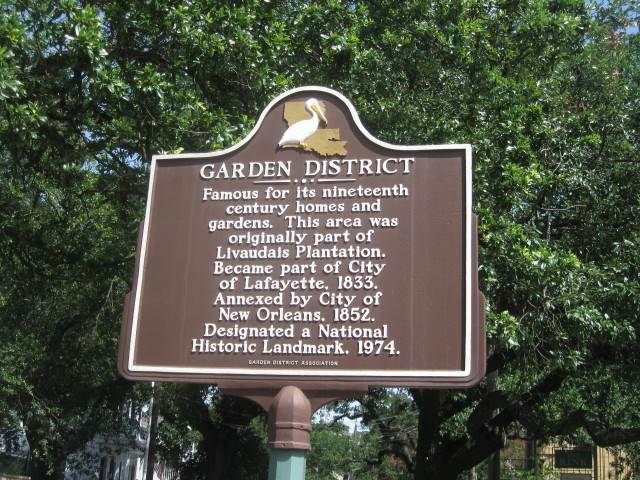
I started my tour armed with
the AAA walking tour guide plus a print out given to me by my
cousin from www.freetoursbyfoot.com on things to see. I took
many photos of interesting homes, but not all had information on
them. The homes that I had information on are posted here.
The fine old homes of the Garden District
preserve traces of the era of cotton and sugar empires, when
grand antebellum plantations dominated the landscape. This was
primarily the American section of town, named for the lush
garden estates.
The district owes its luxuriant vegetation to
an 1816 flood caused by the overflowing Mississippi River.
Although many plantations between Carrollton and the emerging
American sector were destroyed, a rich deposit of alluvial silt
created a very desirable feature for future development- higher
ground. In the early 1830s Jacques Livaudais sold his sugarcane
plantation, which was soon subdivided, later incorporated as the
city of Lafayette and subsequently annexed to New Orleans, where
it became known as the Garden District.
In addition to thriving indigenous and exotic
plantings and magnolia trees rivaling oaks in size, the
neighborhood boasts a variety of building styles, including
Gothic, Greek Revival and Renaissance. Many homes are
embellished with iron lacework, a hallmark of New Orleans
architecture.
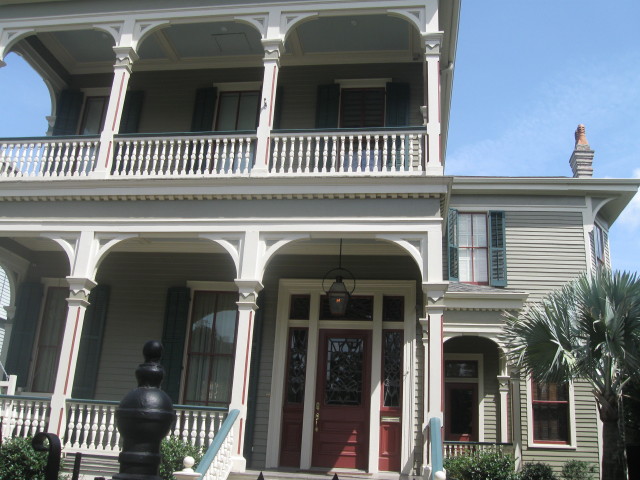
Notice the sky blue ceiling of the porch gallery.
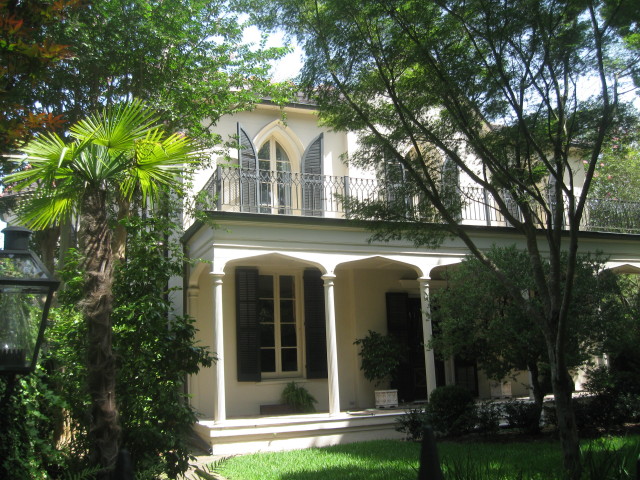
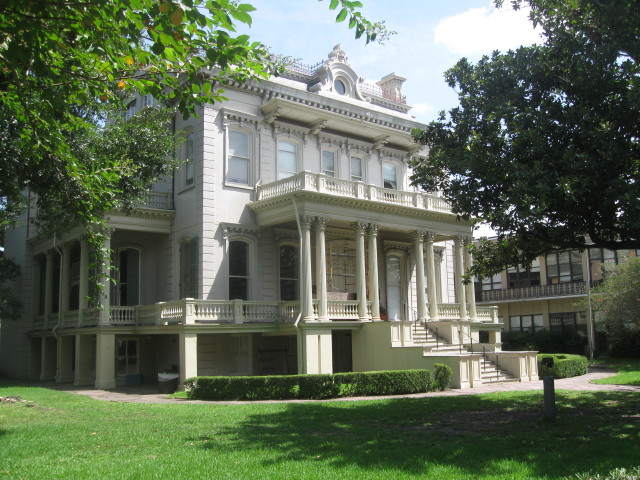
Bradish Johnson House and Louise S. McGehee School 2343 Prytania
St.
Architect James Freret
designed this Second Empire style mansion for sugar baron
Bradish Johnson in 1872. It is quintessential reconstruction era
architecture. Today, the property is the private Louise S.
McGehee School for girls.
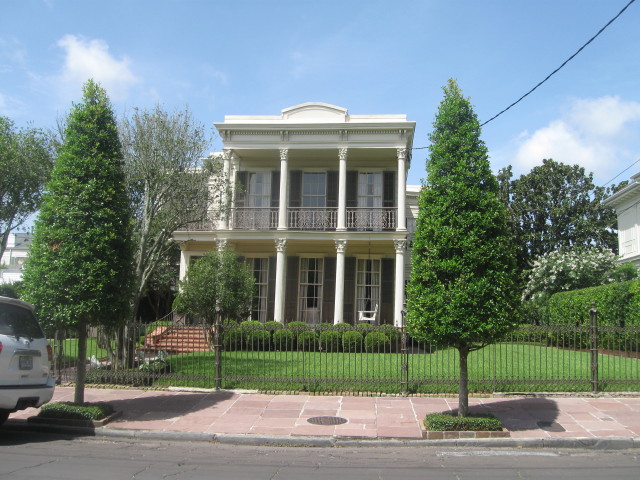
Archie Manning House 1420 First St.
This is the home of former New Orleans Saints quarterback Archie
Manning and childhood home of Peyton, Eli, Cooper Manning. It is
not uncommon to see one of the family members coming in and out of
the house.
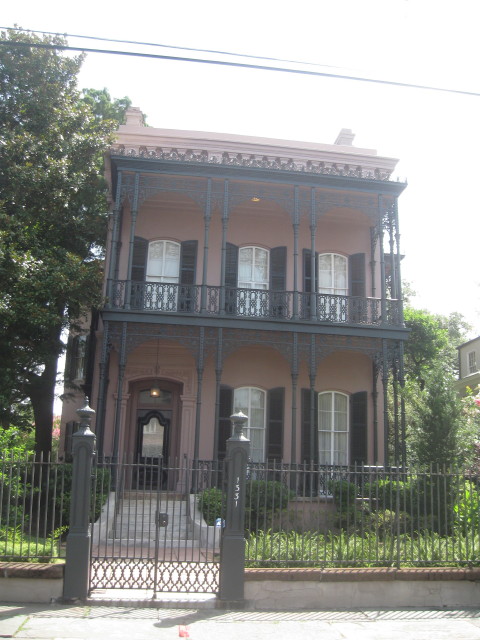
Morris Israel House 1331 First St.
By the 1860's, the Italianate
style was the most popular style of architecture in the Garden
District. You will notice how narrow the home is, but it
continues very far back into the next block. Property tax, which
was calculated by how much of your house fronted the street, was
high during these periods and may have been an instigating
factor in having narrow homes. People who have visited
Disneyland in Anaheim California might recognize this
house as it is the house the Haunted Mansion in Disneyland was
based on. The house is said to be haunted.
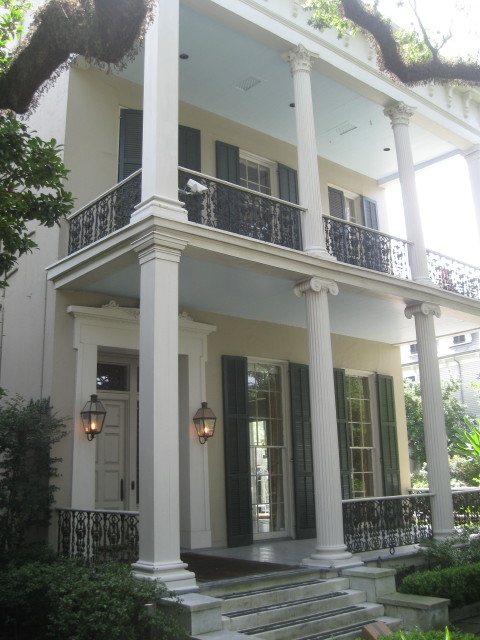
BrevardMahat/ Anne Rice House 1239 First St
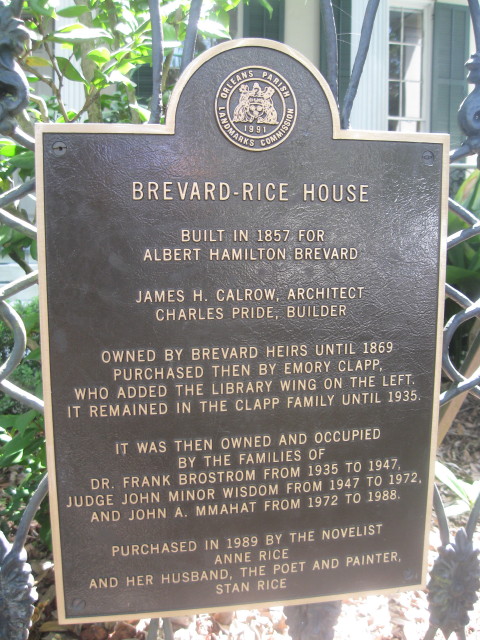
Originally designed in 1857
as a Greek Revival home you can see modern additions like an
Italianate bay have been added. Notice the Rosegate fence, this
is said to be one of the first chain link fences in the world.
However, when people pass by they often speculate that the
rosebuds more closely resemble skulls. When you admire the roses
on the Lattice work on the house they also appear to be cow
skulls. This was the predominant residence of the novelist Anne
Rice and the setting for her Witching Hour novels. She sold the
home in 2003 when her husband Stan unfortunately passed away.
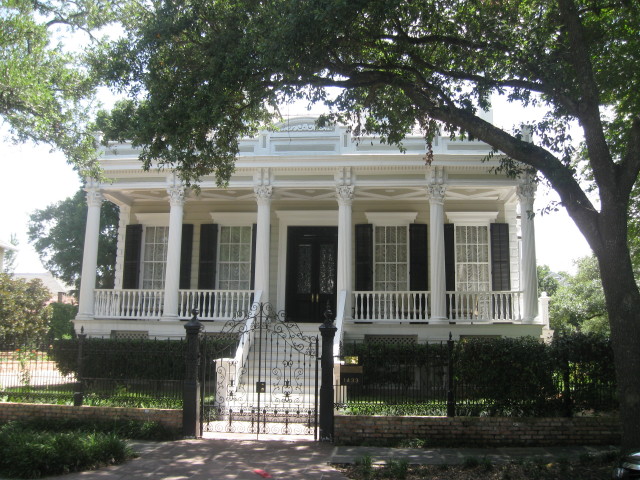
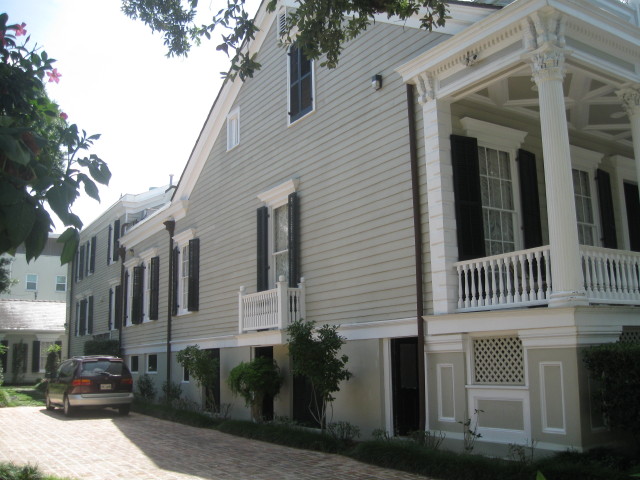
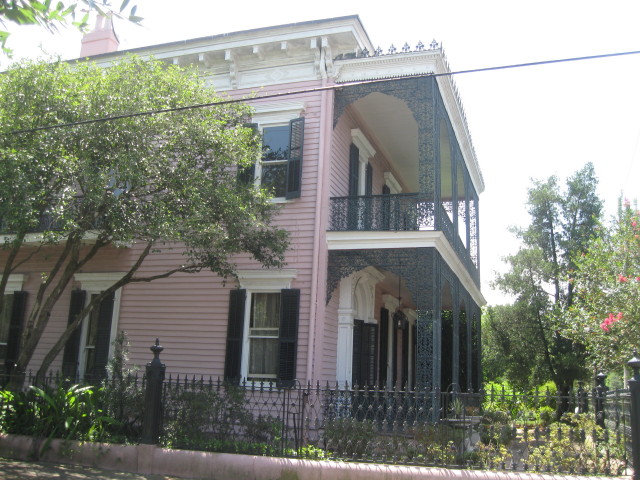
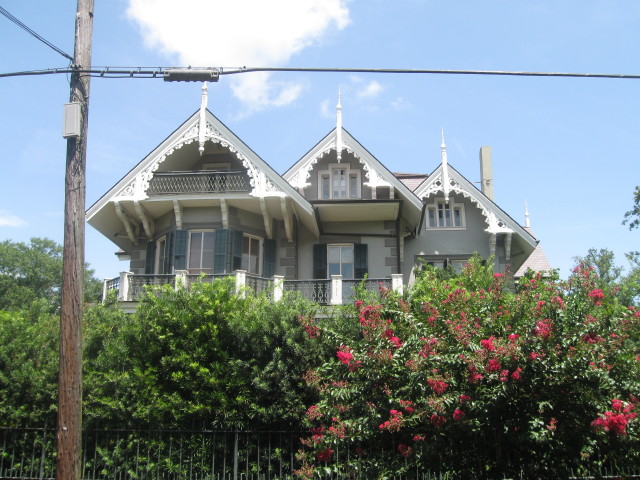
Eustis / Sandra Bullock Residence 2627 Coliseum Street.
This Swiss Germanic Chalet,
built in 1867, is one of only three homes of this style in the
entirety of New Orleans. It is not a practical style of
architecture in a part of the county that gets as warm as New
Orleans does. It was designed by Architect William Freret for
James Eustis, a one-time U.S. Senator. Today, it is the home of
the Oscar winning Actress Sandra Bullock. She bought the home in
late 2009, shortly before her adopted son Louis was born in New
Orleans. People flock to the home, but she is rarely here. She
allows other celebrities to stay inside and you never know who
might come out the front gate.
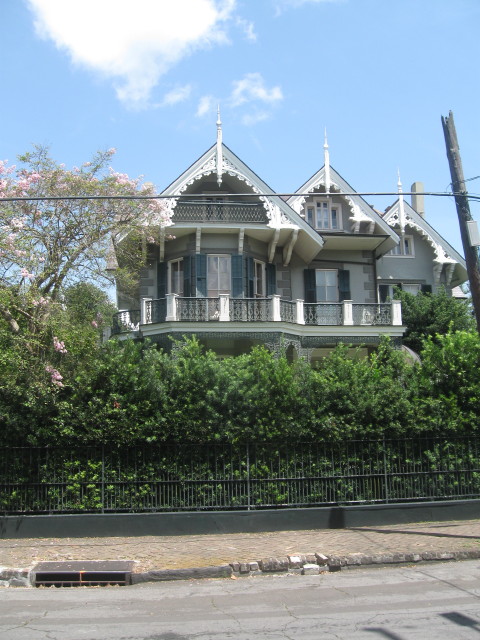
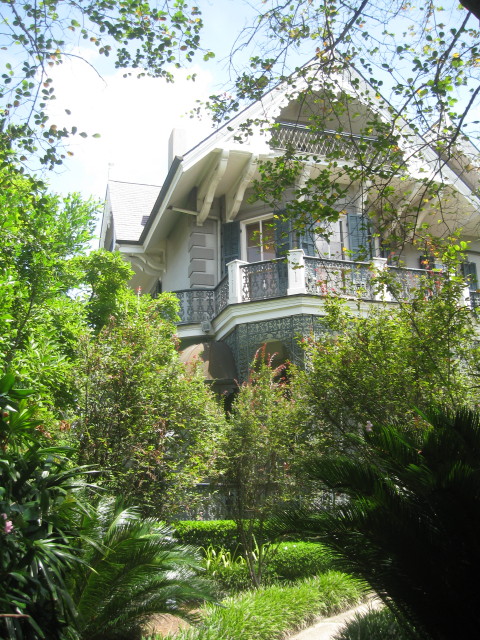
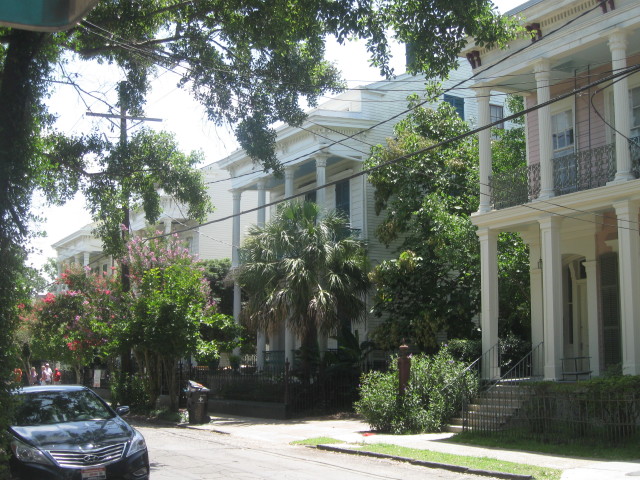
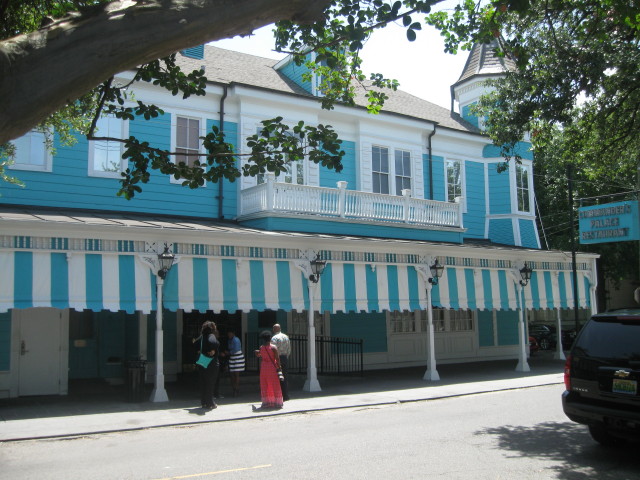
Commander's Palace Restaurant 1403 Washington Ave.
The bright turquoise building
on the corner was erected in 1883 for Emile Commander to be run
as a restaurant. It is now considered to be one of the best
restaurants in the United States and has been owned by the
Brennan family since 1974. Locals attend the weekday Martini
Lunches, but the weekend brunch is also a nice option.
Reservations are required and there is a strict dress code.
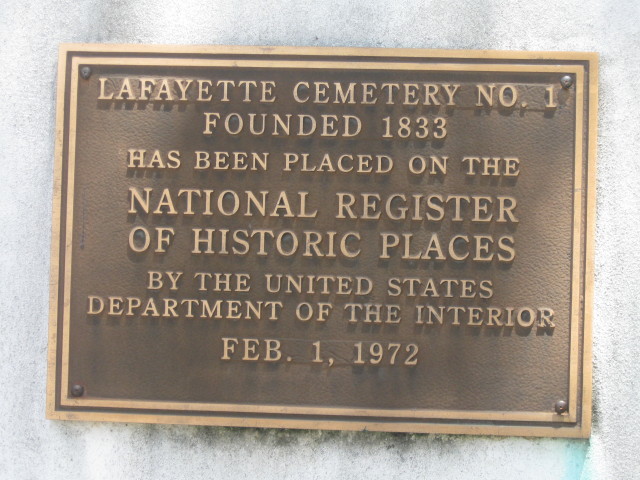
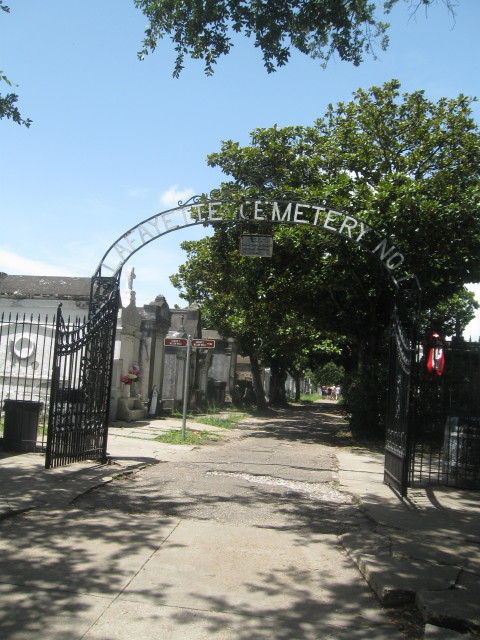
The cemetery entrance is in
the middle of Washington Ave. and directly opposite Commander's
Palace restaurant. Once part of a plantation, Lafayette was New
Orleans' first planned cemetery, opened in 1833 for immigrants,
affinity groups and the wealthy, and even today welcomes new
occupants weekly into its 1,100 tombs.
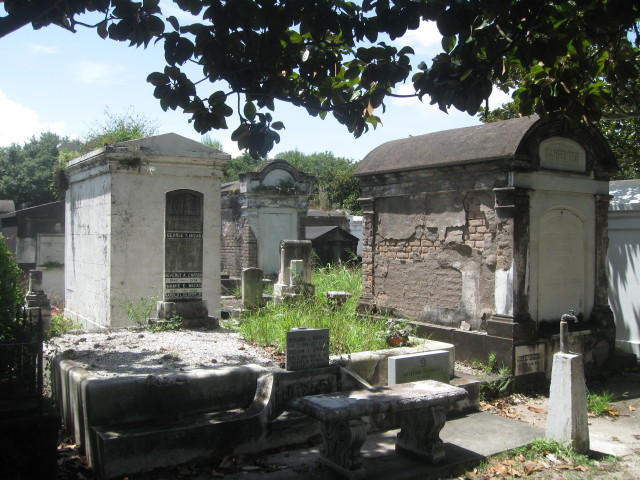
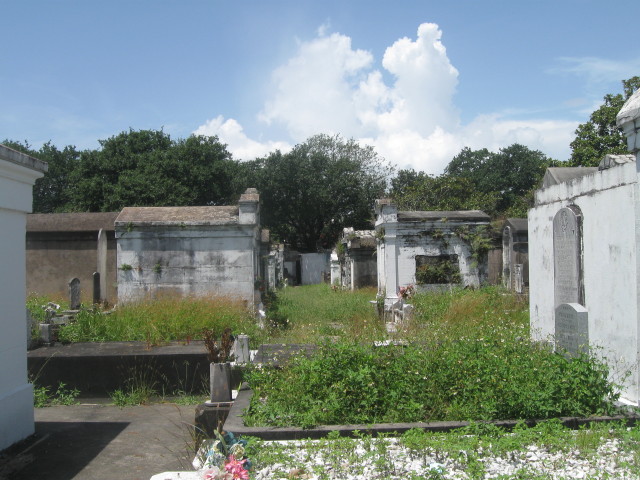
This municipal cemetery is
the third oldest still standing cemetery today. Due to no
affiliation with the Catholic Church there are over 27 different
nationalities interred in the cemetery today.
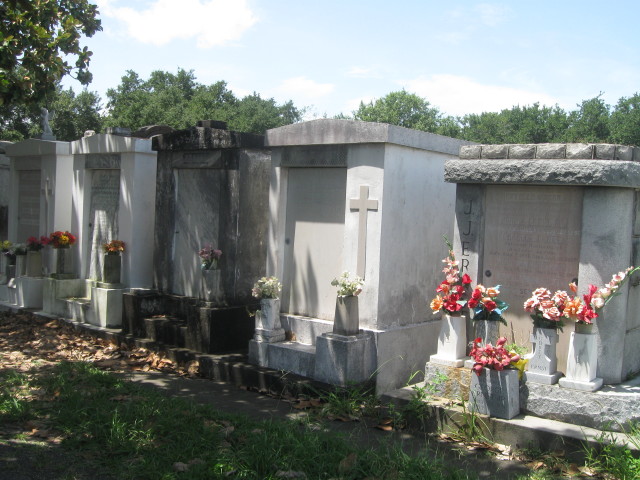

Due to Southeast Louisiana's
high mortality rate the cemetery's structures were erected at
break neck speed. Walking down the center aisle on the right are
4 tombs and you will see a grave Sercy, Mary Love and Edwin's
children all passing away within 24 hours of each other. You
then begin to realize how death helped to mold the way of life
in the region. You will notice the above ground tombs that are
so popular in New Orleans. Done for practicality as well as
tradition you see them in abundance. Embalming was not used
predominantly in North America until after the American Civil
War. When the deceased were place inside of the tombs without
embalming it was realized the tombs were like ovens and the
disintegration process would be accelerated. For that reason you
can find tombs with up to 35 family members inside.
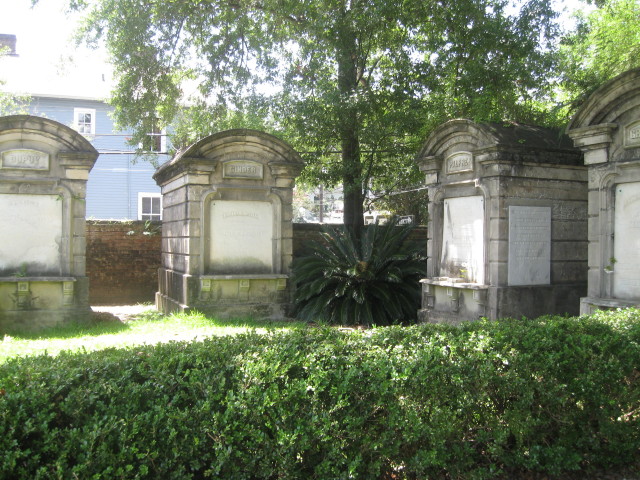
Just about everyone says the
dead are buried above ground because New Orleans is below sea
level. "Not true," said guide John Geiser. "We're standing 8
feet above sea level here." Although half of inhabited New
Orleans now is below sea level, much of this part wasn't
developed until the 20th century. Geiser said the earliest
graves were holes in the ground by the Mississippi River, but
after 20 or 30 years, the French settlers decided to copy the
burial style they knew in France - above-ground tombs.
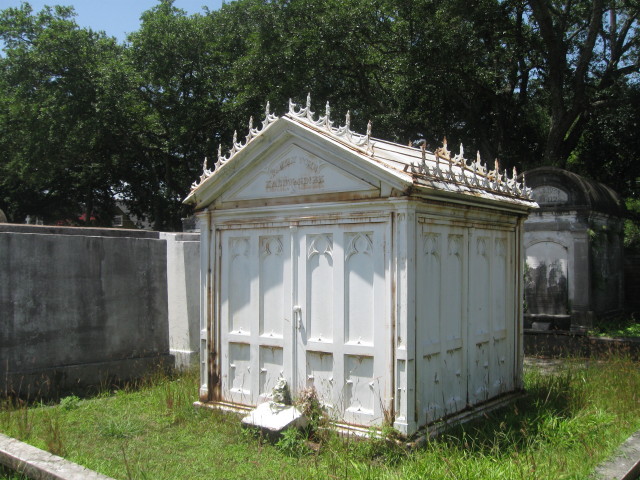
This tomb was used in the Tom Cruise film "Interview with the
Vampire-The Vampire Chronicles." Tom Cruise refused to enter the
tomb as called for in the script. The studio built a false front
so Tom could enter without going inside.
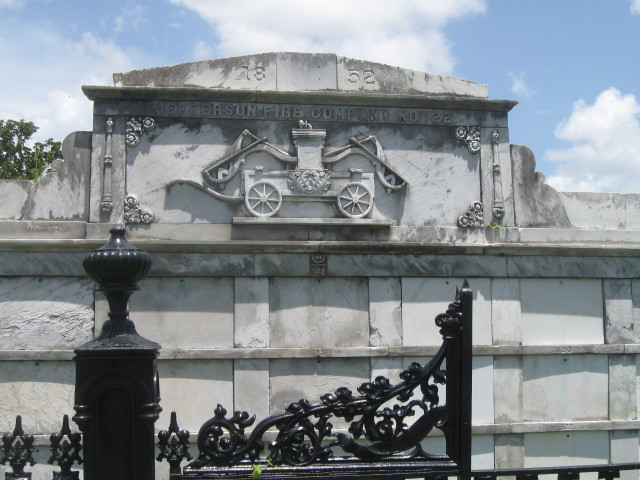
The Jefferson Fire Companies Benevolent Tomb.
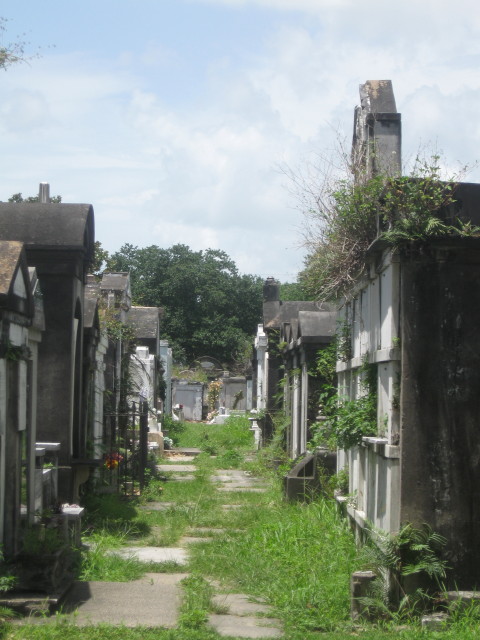
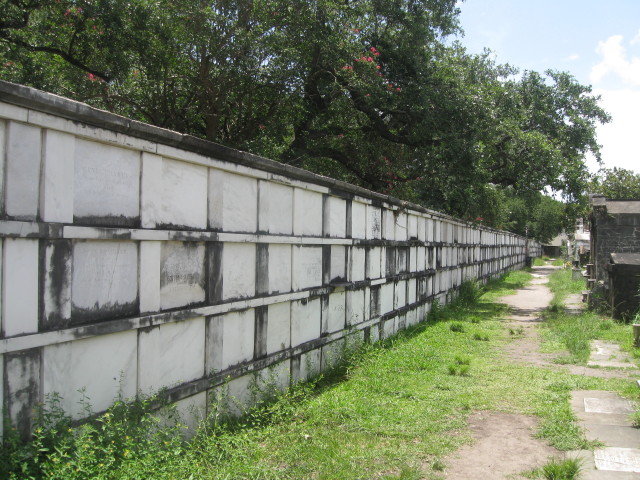
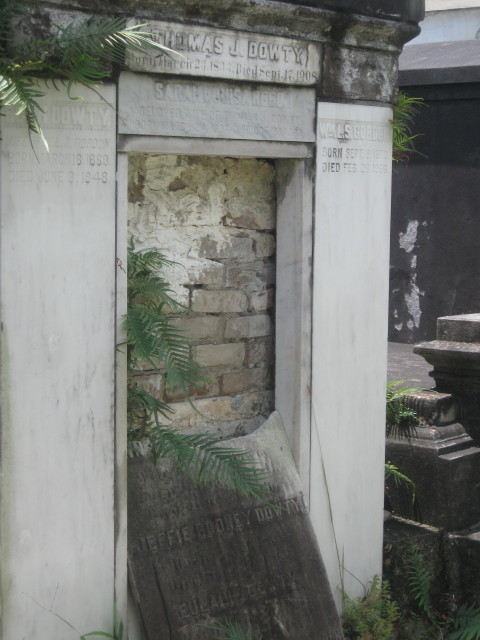
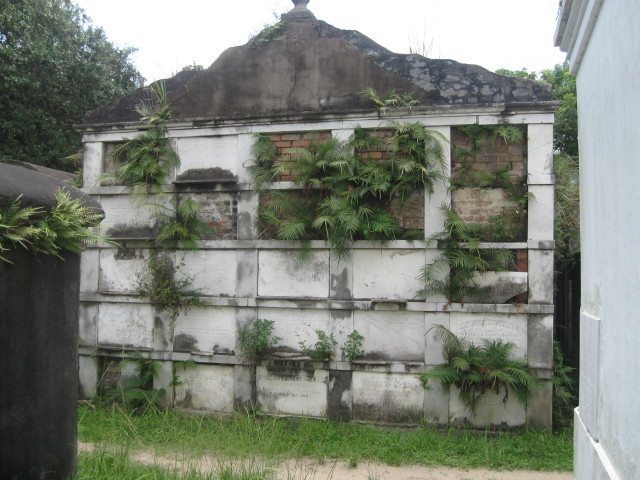
Leaving the domicile of the departed after a uneventful visit, I
had one more street to cover in the Garden District.
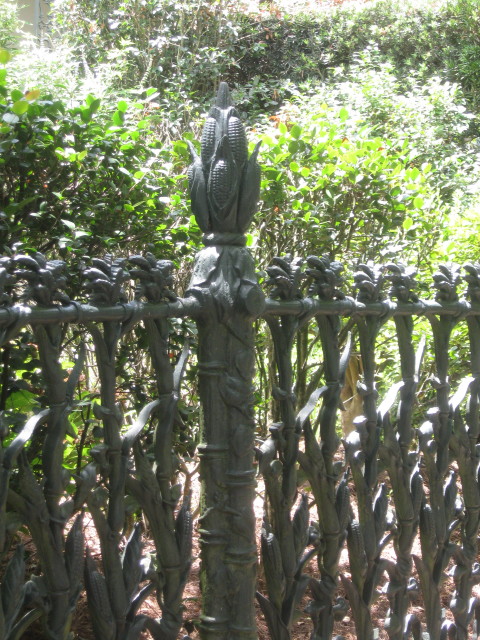
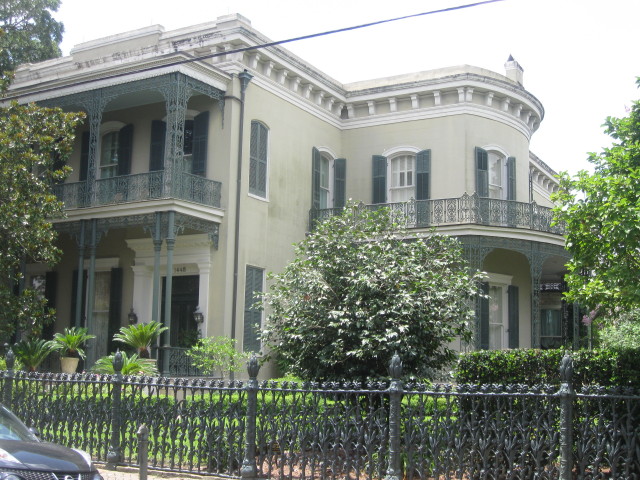
Colonel Short's Villa 1448 Fourth St.
This house was built by
architect Henry Howard for Kentucky Colonel Robert Short in
1859.The story goes that Short's wife complained of missing the
cornfields in her native Iowa, so he bought her the cornstalk
fence. An explanation given by the current owners is that the
wife saw that it was the most expensive fence in the building
catalog and may requested it. Governor Nathaniel Banks lived
inside with Major General Benjamin Butler after the property was
commandeered in September of 1862. New Orleans fell early in the
war as it was a pivotal port for the Union. Best thing to happen
so that New Orleans was not destroyed in Sherman's March.
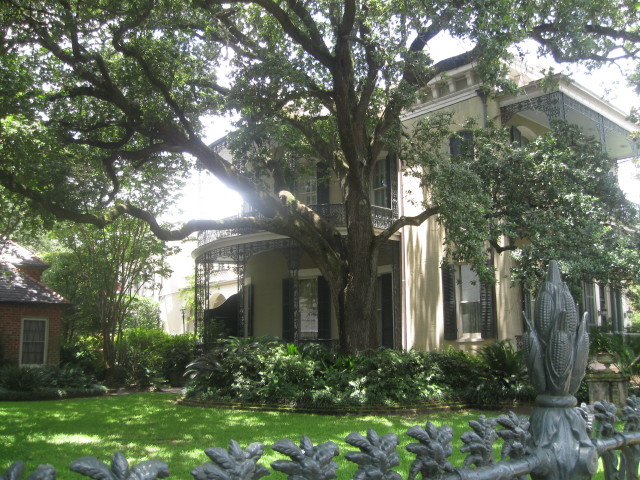
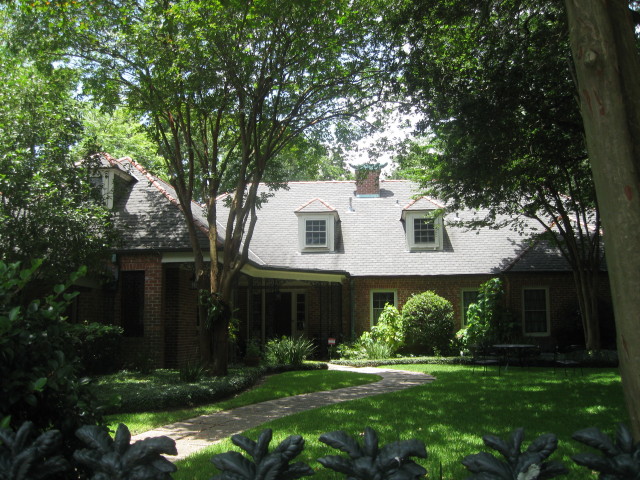
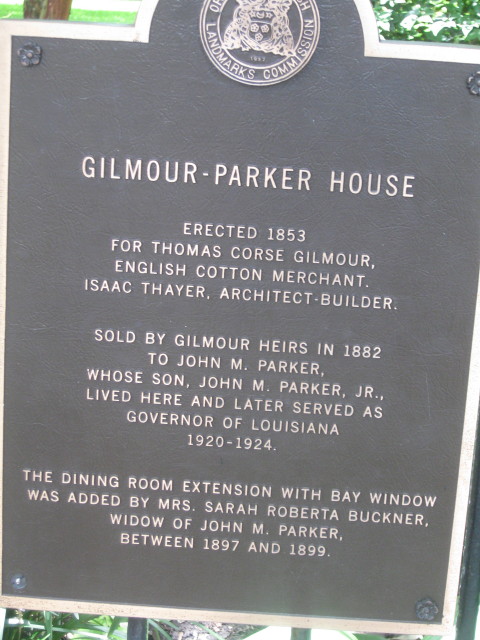
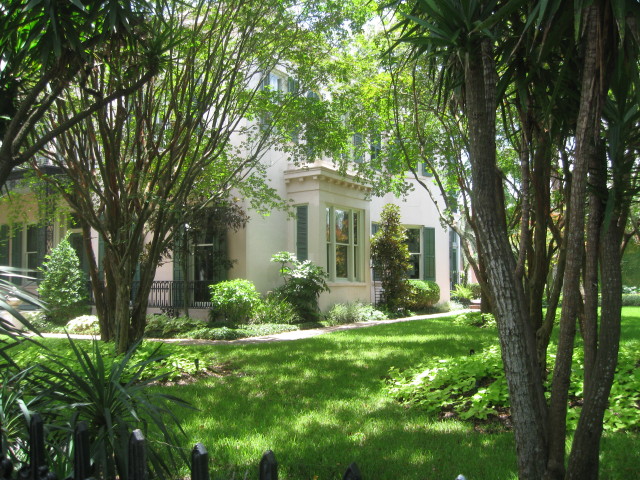
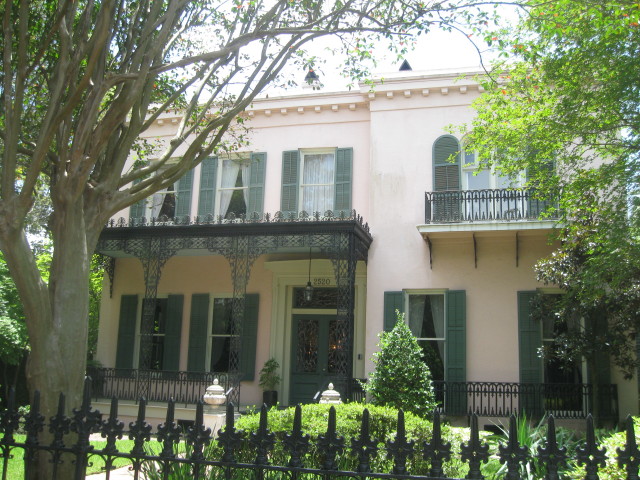
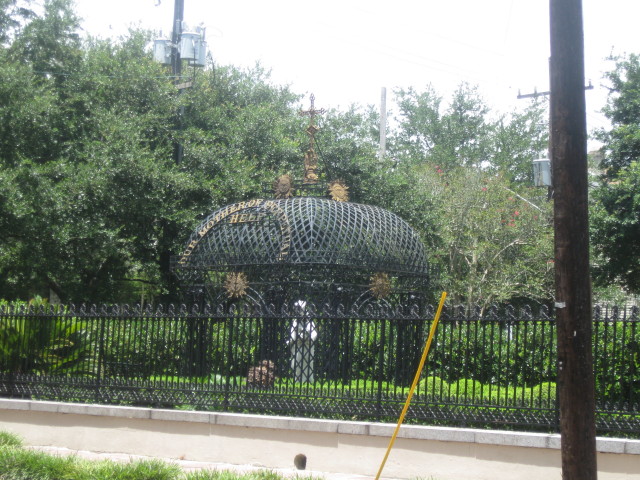
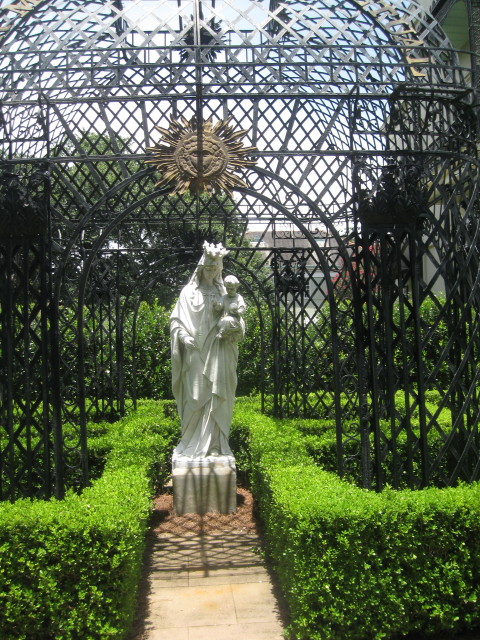
Our Mother of Perpetual Help Chapel 2523 Prytania St.
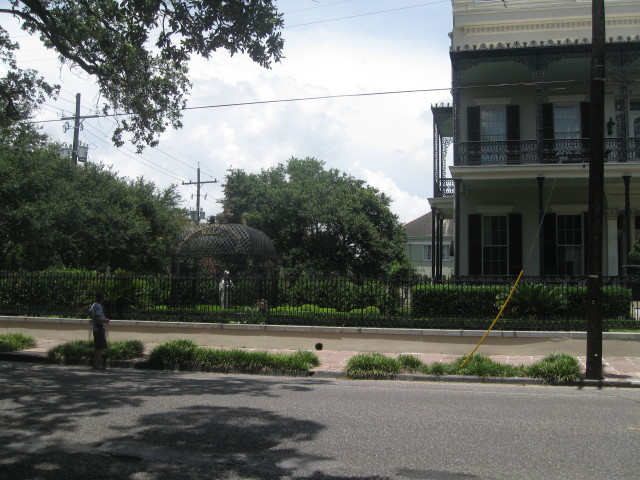
The
beautiful Madonna and canopy in the yard denotes a small
Catholic chapel, used to stand here until Anne Rice, author of
Interview with a Vampire, purchased the property. It's the
setting for her novel Violin. The home was designed by the
Architect Henry Howard in 1857. He predominantly used the
Italianate style that you can see. Italianate homes in the
Garden District on average have 17 foot tall ceilings. You will
also notice the exquisite metal work adhered. When looking at
the metal columns you will notice Romeo Spikes. Folklore
states that they were installed to keep young men from climbing
into young women's rooms. Most likely, they are there to prevent
robbery. You will also notice a gas light on the porch that
burns all day and all night. That is upholding the tradition
that J.H. Caldwell arrived in New Orleans in 1833 and started
installing the gas lines into homes throughout the region. The
Garden District would have never be without light.
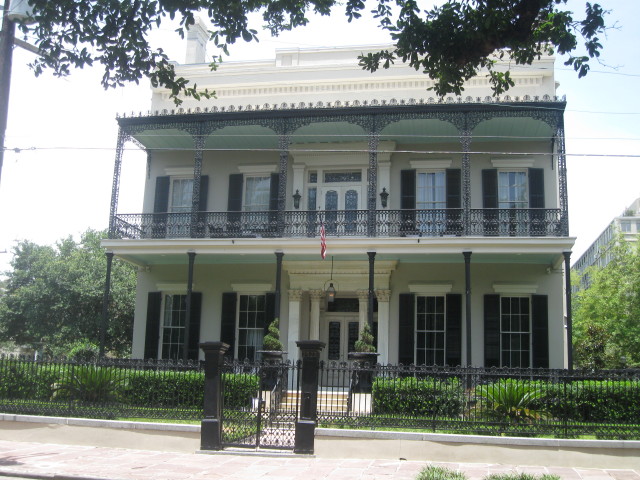
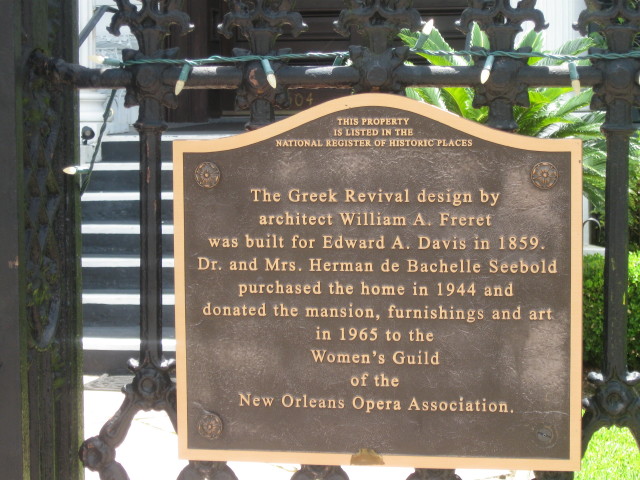
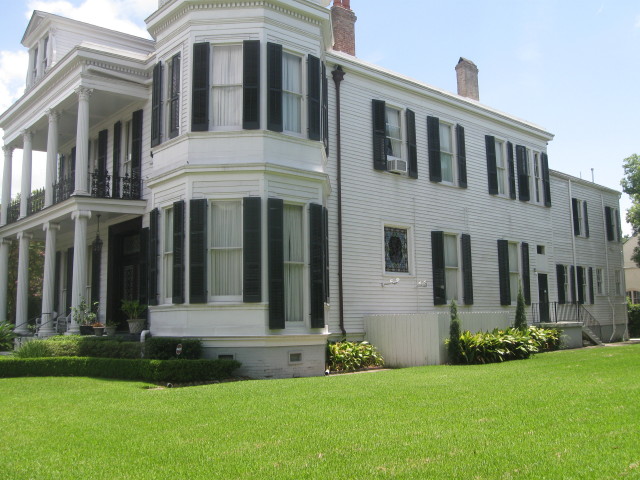
The Women's Opera Guild House 2504 Prytania St.
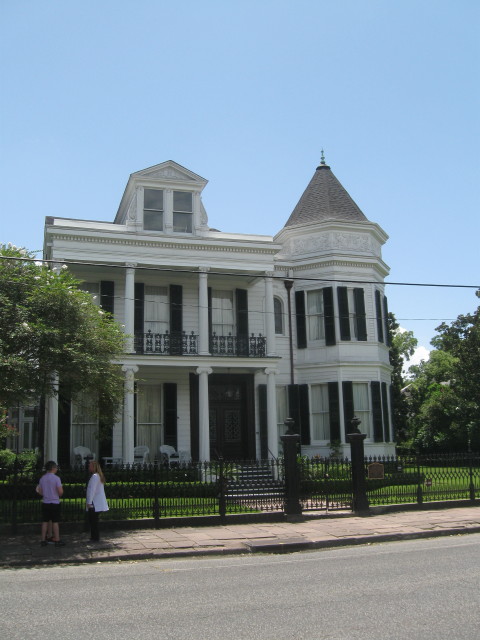
The stand out homes in Garden District's often include more than
one style. Designed by William Freret in 1859, this building
combines Greek Revival and Italianate metal work with Queen Anne.
Now owned by the Women's Opera Guild, the home can be toured on
Monday's from 1 to 4 pm.
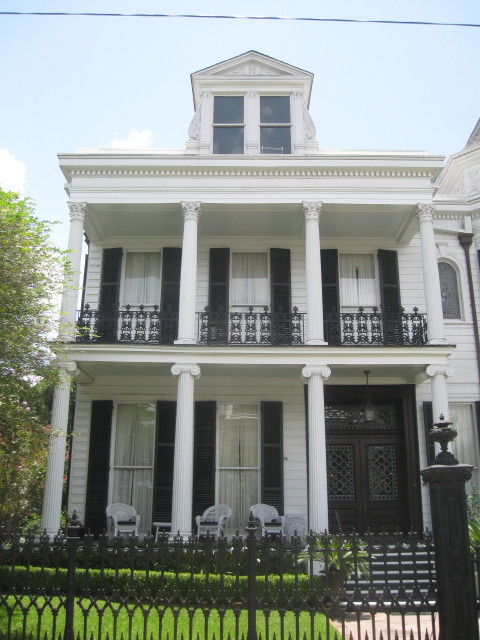
This home was the last stop on the tour and back to where I began.
From this point it is only one block left to St. Charles and the
streetcar.
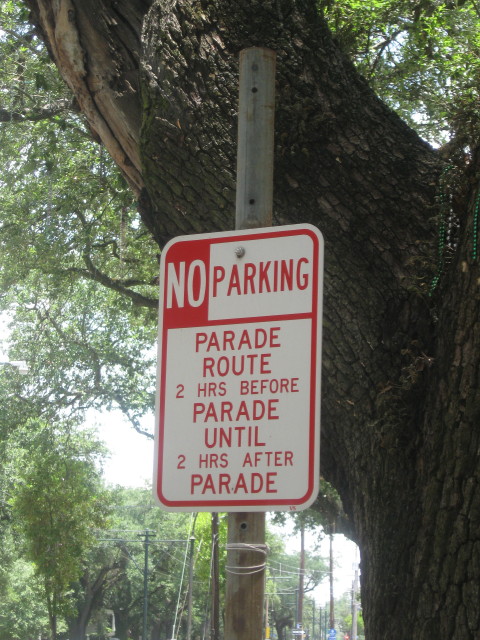
St. Charles Ave is one of the parade routes for Mardi Gras.
The event synonymous with the
city - and into which it pours its whole soul - is Mardi Gras.
This Catholic holiday originated as a final farewell to food and
drink before the fasting of Lent, which begins on Ash Wednesday.
Carnival season in New Orleans starts on Twelfth Night, Jan 6,
with a series of glittering private balls and costume parties.
The celebration reaches its peak during the 2 weeks leading up
to Shrove Tuesday, better known by the French as Mardi Gras
("Fat Tuesday"), when carnival krewes stage more than 60 parades
across the city. My cousin said that she and her husband had
ridden in several parades with his krewe -Hermes.
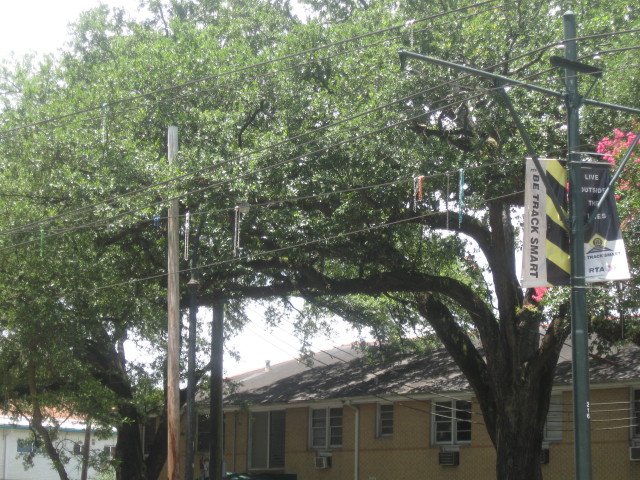
From here I boarded the
streetcar and rode back to the hotel.
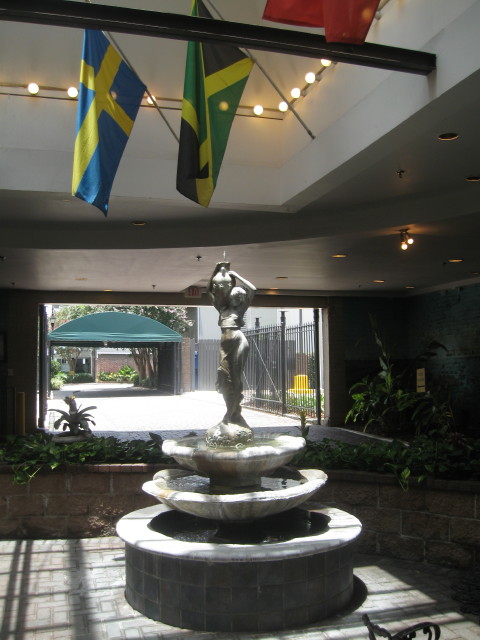
Hotel's motor court.
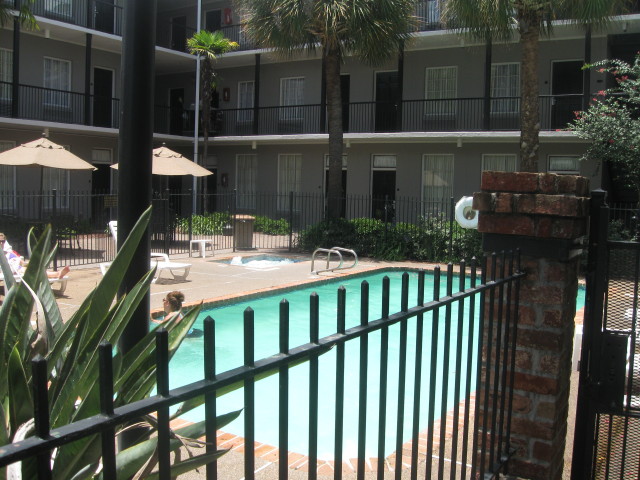
Pool and a very nice whirlpool.
I talked to my cousin and she
said that she would come by in a bit and take me to sightseeing
some more of the city. After we meet up, she drove though part
of the French Quarter and by the French Market Place.
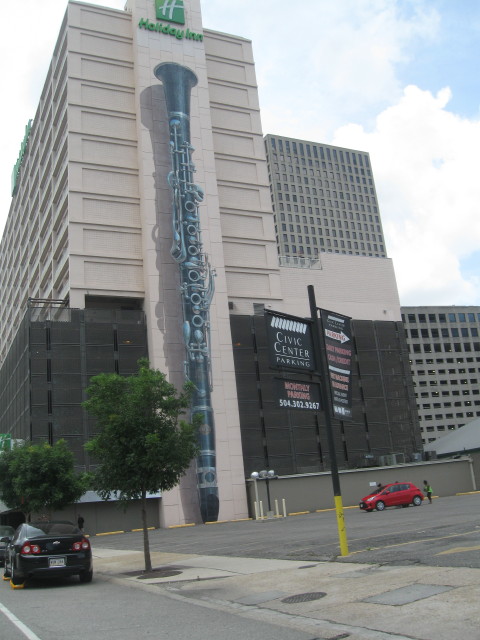
You think Pete Fountain is big here in New Orleans.
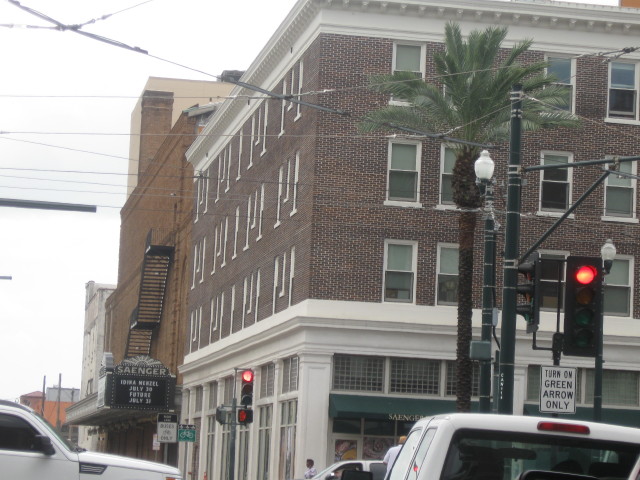
The Saenger Theatre, at Canal and Rampart Streets, sponsors a
Broadway series, bringing major touring companies to the Big Easy
each year. Completed in 1927, the restored opulent Italian
Renaissance theater gives patrons an outdoors feeling with a
ceiling of stars and clouds and a special affects machine
that simulates sunrises and sunsets. Additional features include
chandeliers from the Palace of Versailles and a 778-pipe organ.
Leaving the French Market
District in the French Quarter and passing The Old U.S. Mint, we
are on Route 46, going through the same neighborhood as
yesterday and ending up at the same location only next door.
Chalmette Battlefield
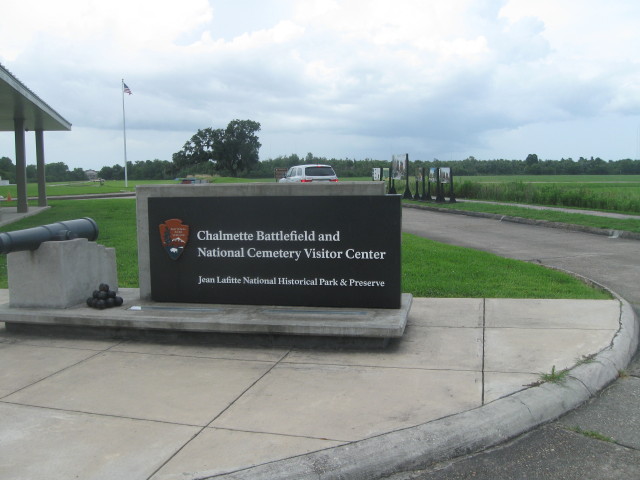
We parked and walked over to
the Visitors Center. Inside we saw excellent displays, maps,
interactive exhibits and films that explain the importance of
Louisiana and the Battle of New Orleans in the War of 1812.
Afterwards we went outside to look at the battlefield.
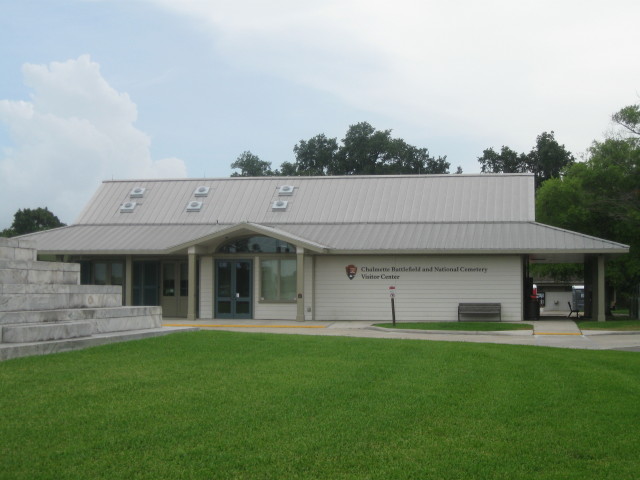
The Battle of New Orleans
Maj Gen.
Andrew Jackson's stunning victory over experienced British
troops in the Battle of New Orleans on January 8, 1815, was the
greatest American land victory of the War of 1812. Although the
Treaty of Ghent, ending the war, was signed in Belgium on
December 24, 1814, it was not ratified by the United States
until February 1815, so fighting continued. This battle
preserved America's clam to the Louisiana Territory, prompted
migration and settlement along the Mississippi River, and
renewed American pride and unity. It also made Jackson a
national hero.
The War of 1812 was fought to secure US
maritime rights, reduce British influence over American Indians
on the western frontier, and pave the way for the US annexation
of Canada. Neither side had much success in the early days of of
war. Great Britain, battling Napoleon's armies in Europe, could
spare few troops to fight in the US; most were sent to defend
Canada. America had few victories, most of which were at sea.
When Napoleon was defeated in the spring of 1814, the War of
1812 changed dramatically. Thousands of battle-tested British
troops sailed for the United States, for a three-pronged attack
that included a full-scale invasion from Montreal; skirmishes
and raids on Washington, DC, and Baltimore; and an attack on New
Orleans.
The first advance ended when the British lost
the Battle of Lake Champlain in September 1814. During the
second, the British invaded Washington and burned the White
House and Capitol, but Fort McHenry in Baltimore held off
British ships, ending this attack. The third began in late
December when British Maj. Gen. Sir Edward M. Pakenham led a
10,000 man army overland from Lake Borgne to attack New Orleans.
The capture of this important port was Britain's main hope for
exacting a favorable peace settlement from the Americans. By
controlling the mouth of the Mississippi River, England could
seriously threaten the economic well-being of the entire
Mississippi Valley and hamper US western expansion.
Defending New Orleans were about 5,00 regular
US troops, state militiamen, and volunteer soldiers, including
Jean Lafitte's Baratarian pirates. On December23, British troops
landed nine miles downriver from New Orleans,Jackson halted
their advance in a fierce night attack. The Americans then
withdrew behind the banks of the Rodriguez Canal.
The Rodriguez Canal bordered one side of the
Chalmette plantation, running between the Mississippi River and
a cypress swamp. Jackson's plan was to force the British to
march through the stubble of harvested sugarcane fields toward
his troops. Americans enlarged the canal and filled it with
water, built a shoulder high mud rampart thick enough to with
stand cannon fire, and waited for the British to attack.
Pakenham tested the Americans' nerve and
firepower with a reconnaissance on December 28 and again on
January 1. When these efforts failed, he knew he must either
withdraw, risking an American attack, from the rear, or assault
Jackson's rampart. Relying on good leadership and his experience
soldiers, he chose to attack.
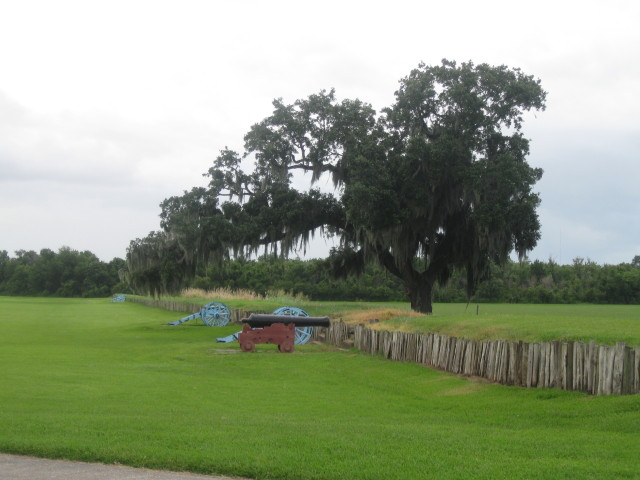
On January 8, 1815, Pakenham
sent 7,000 soldiers head on against the American position. The
British concentrated their attack on the rampart's ends,
assuming those were the weakest points, but the fire from
Jackson's artillery and small arms tore through their ranks with
devastating effect.
As the British assault against the American
rampart near the swamp begin to falter, the 93rd Highlanders
were ordered to march diagonally across the battlefield from
their position near the Mississippi River. The regiment was
exposed to raking fire and suffered heavy casualties. Pakenham
rode forward to rally his men and was mortally wounded. Many
other high-ranking officers, including Maj. Gen. Samuel Gibbs
and Maj. Gen. John Keane, were killed or wounded. Although a
small force continued a brave advance, Gen. John Lambert, the
surviving British commander, ordered a retreat.
The Battle of New Orleans lasted less than
two hours, with the major fighting confined to about 30 minutes.
More than 2,000 British troops were dead, wounded, or taken
prisoner; American casualties numbered fewer than 20. With days
the British withdrew, ending the Louisiana campaign.

Looking across this open field and where you see the smokestacks
and pipes of a modern oil refinery, a British army was camped from
December 23, 1814, through January 8, 1815. After a night battle
in the British camp on December 23, General Jackson's forces fell
back to this spot, where they spent Christmas 1814 constructing a
defensive rampart at this location behind the Rodriguez Canal.
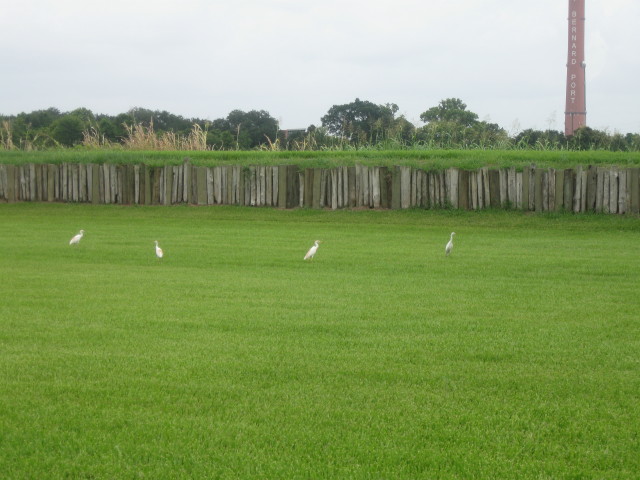
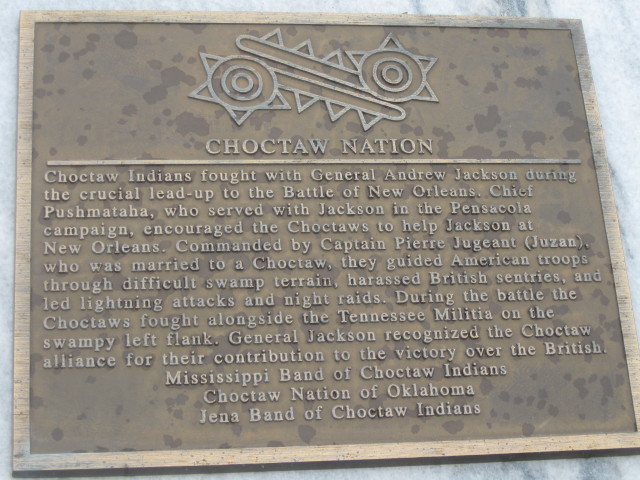
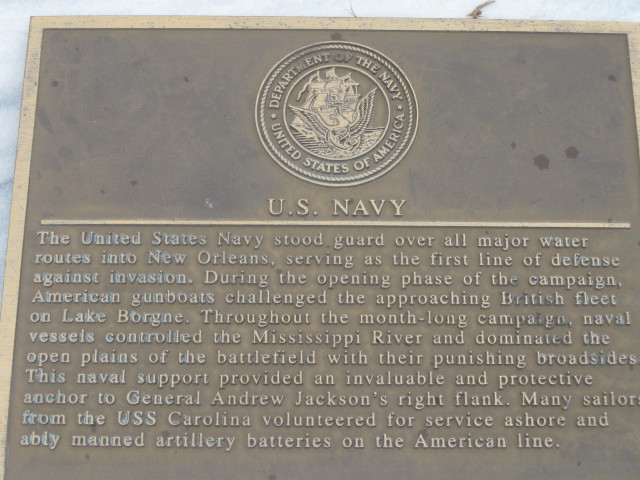
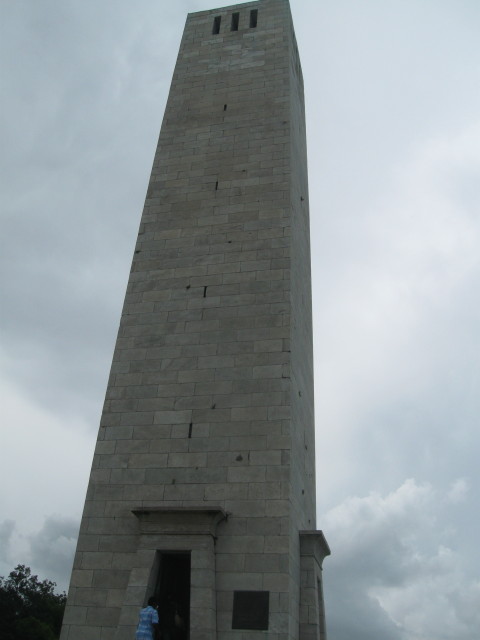
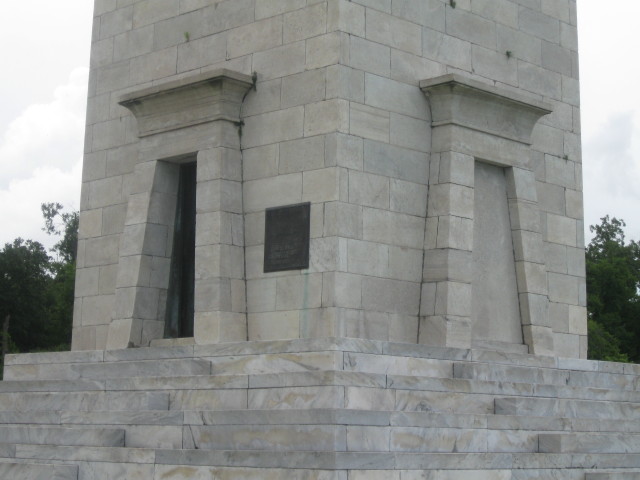
Chalmette Monument.
The cornerstone of this shaft honoring the American victory at New
Orleans was laid in January 1840, within days after Andrew Jackson
visited the field on the 25th anniversary of the battle. The State
of Louisiana began construction in 1855, and the monument was
completed in 1908.
The British left Louisiana
after their defeat at the Battle of New Orleans, turning their
attention back to Europe and what would be their final battle
with the French Emperor Napoleon at Waterloo and the end to
more than 20 years of war. Canadians were proud to have
defended their border against American invasion. Americans
were counting their blessings for having ended the War of 1812
on agreeable terms and feeling a new sense of pride in their
nation and its ability to overcome differences in a common
cause. The American victory also secured the lands of the
Louisiana Purchase and encouraged white settlers to move into
American Indian lands to the west without the worry of
interference by any European powers.
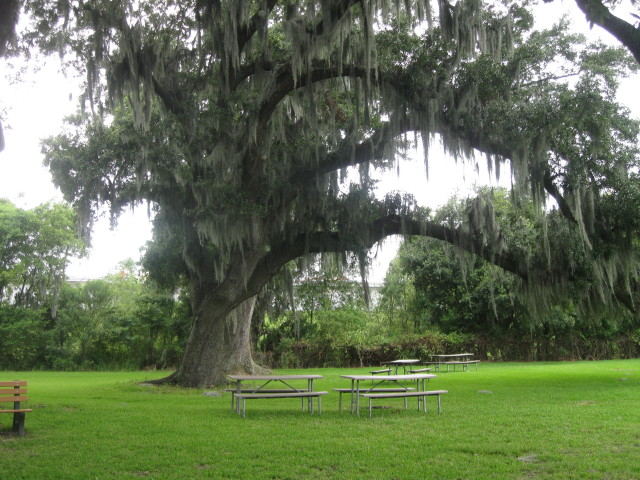
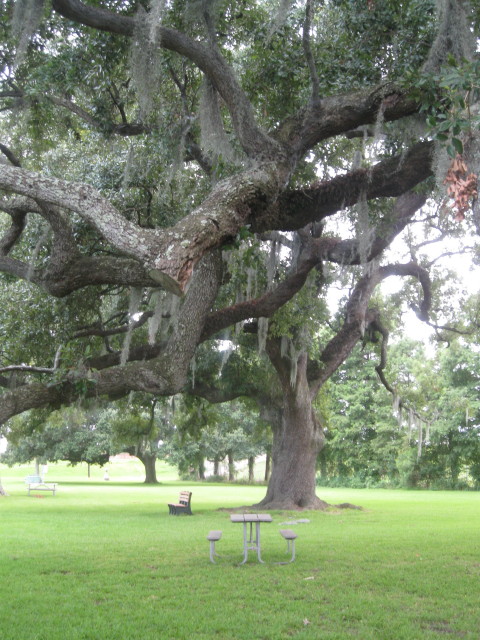
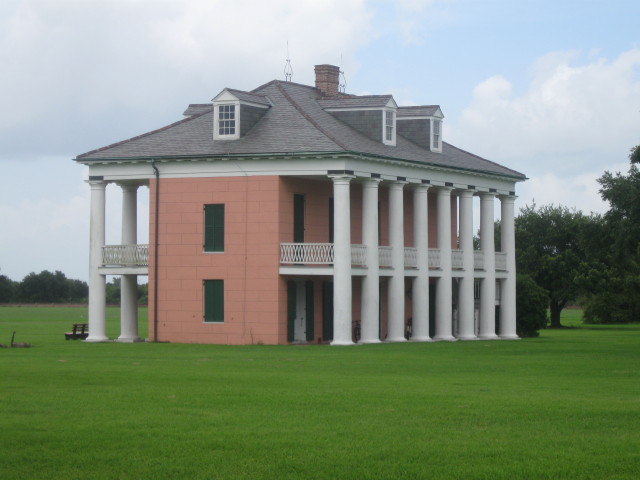
The Malus-Beauregard House
was not here when British troops crossed the field in January
1815. However, its early 1800s architecture offers a convenient
historical backdrop to explore the scene of the British troops
assembled to capture New Orleans.
It may surprise you to know that some English
ladies accompanied their husbands across the ocean. As the
soldiers slept in swamps and suffered from the cold on their way
to New Orleans, the women remained in the relative comfort of
the ships. Waiting for the news of a British victory and the
opportunity to visit the exciting city of New Orleans, they
played games, read books, and enjoyed theatrical performances on
the decks of their ships. These women would never see New
Orleans, and some would never be reunited with their husbands .
The fallen soldiers were buried at the plantations near the
battlefield, and the women returned to England with the fleet.
From the battlefield, Dawn and I walked to
the top of the levee for a look at "Ol' Man River."

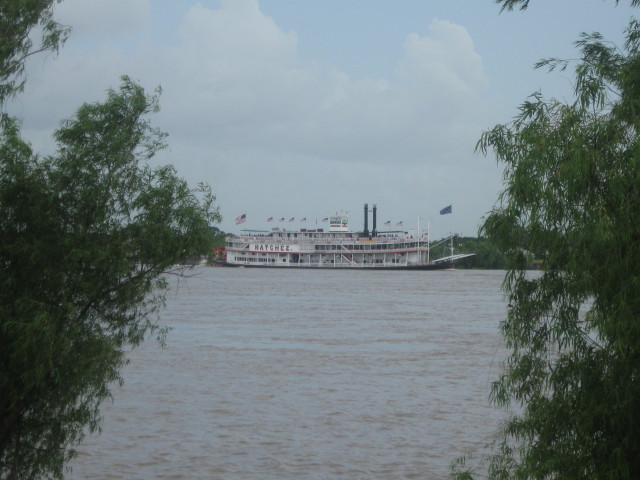


Battlefield dock.
The Paddlewheeler
Creole Queen has a historical battlefield
cruise where passengers can disembark and learn about this
decisive battle that changed American history.
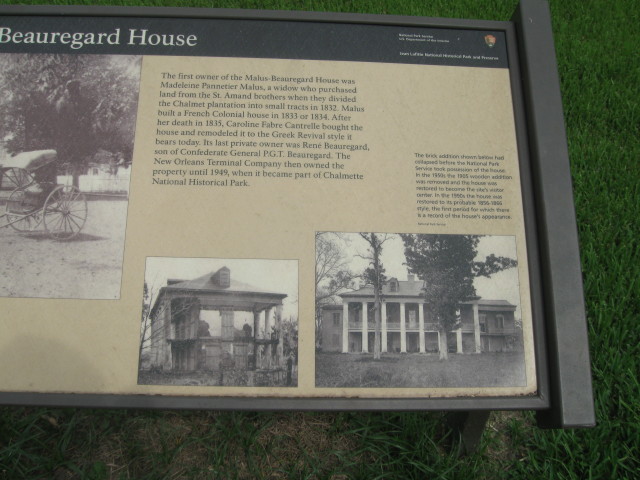
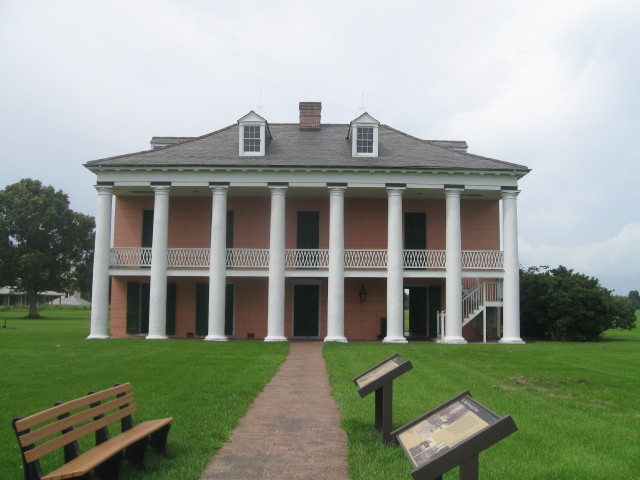
Leaving the levee we walked over to the Malus-Beauregard House.
Built nearly 20 years after
the Battle of New Orleans, the house is named for its first and
last owners. Madeleine Pannetier Malus and Judge Rene'
Beauregard. Today's restoration reflects the Greek Revival style
of a mid 1800s home. We walked inside for a look. Not much to
see, just bare walls and several rooms.
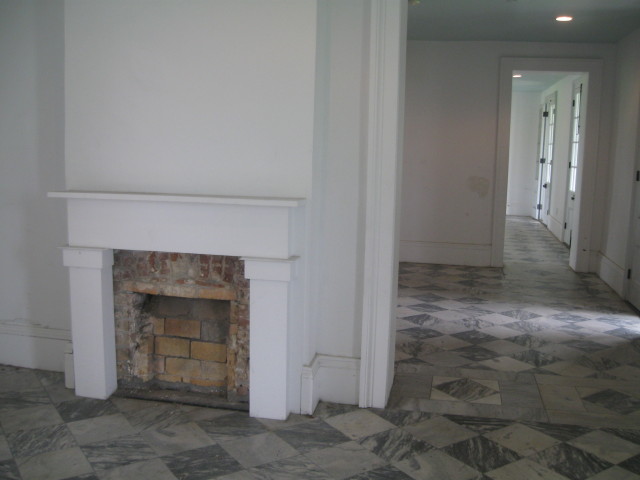
From here we returned to the
other side of the city and drove to Audubon Park where we
stopped to view the river. As it was a holiday weekend, the park
was filled with picnickers, people playing ball and others just
relaxing on a summer evening. In 1884-85 Audubon Park was the
scene of the World's Industrial and Cotton Exposition, which
started the world with electric lighting indoors and out.
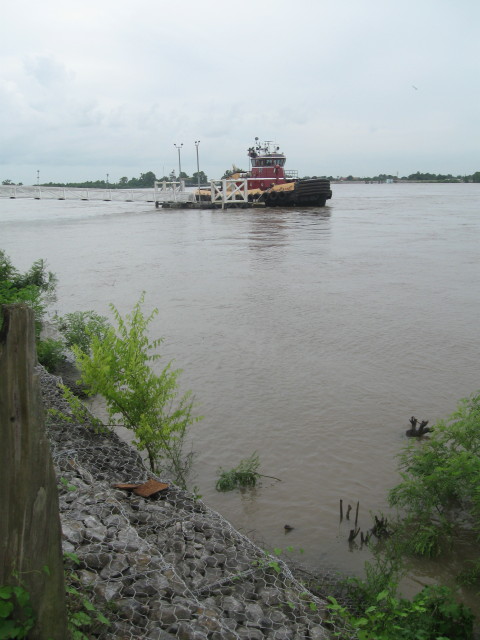
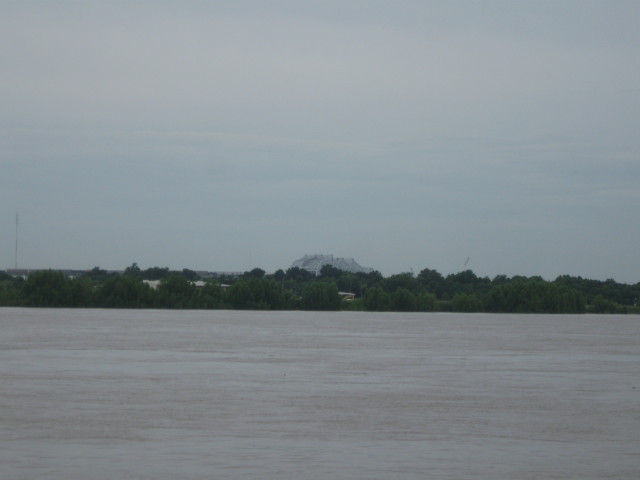
Huey P. Long Bridge in distance.


After our visit to the park, Cousin Dawn dropped me off at the
hotel and we said good-by and I thanked her for taking time to
show me around town. Later on I went out to the pool area and
spent a hour or so relaxing in the warm water and talking with
fellow travelers. Later fireworks were seen and heard in the
night sky.
Tomorrow -Original Beignets and Cafe' Au Lait at Cafe' Du Monde,
walking tour of the French Quarter and a river crossing to Algiers
Go to next Chapter
Twenty-eight
Return to last Chapter Twenty-Six St Charles Street Car,
Chalmette Cemetery
Robin's trips
Home Page
Text and Photos by Author
The author retains
all rights. No reproductions are allowed without the
author's consent.
Comments are appreciated at...
yr.mmxx@gmail.com
